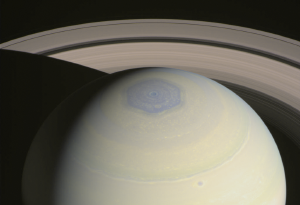Blog
Six Degrees
of Isaac Newton
17 April 2014
 NASA / JPL-Caltech / SSI / Val Klavans
NASA / JPL-Caltech / SSI / Val KlavansThere is a hexagonal cloud pattern at the north pole of Saturn. It was first discovered by Voyager in 1981, and was still there when Cassini arrived at Saturn in 2006. So it seems the pattern has been stable for more than 30 years. There’s been a great deal of debate about just how such a stable geometric shape could form in Saturn’s clouds, but it turns out the solution is surprisingly simple, and it traces back to some early experiments of Newton.
 Ana Claudia Barbosa Aguiar
Ana Claudia Barbosa AguiarAlthough it seems unusual, the effect is fairly common in fluid motion, and has been observed in similar phenomena such as hurricanes. It turns out to be due to an interaction between two regions of fluids moving at different speeds, which produces a kind of resonance between them. The effect has been recreated in the lab by having a spinning ring in the center of a cylinder of water.
It’s interesting that this effect can be seen in what is basically a rotating bucket of water, but it goes to show that sometimes a simple experiment can lead to surprising results.
Isaac Newton performed a similar experiment, and it puzzled him as well. He was interested in the aspects of rotation, specifically why the surface of water becomes concave when it’s in a rotating bucket. The answer might seem obvious, simply that rotating water tends to fling to the outside due to a centrifugal force, but it isn’t so simple. In Newtonian physics, motion is relative to other objects. So if you argue that it is simply due to the spin of the bucket, what is the spin relative to?
Newton thought the experiment demonstrated that there is an absolute frame of reference. Basically a fixed and universal reference frame against which all motion can be measured. Thus, the bucket rotates relative to this universal frame, thus the water becomes concave.
In the 1800s, Ernst Mach argued against Newton’s absolute frame. He claimed that Newton’s conclusion was wrong because the bucket was rotating relative to the Earth, and relative to other objects in the universe. Thus one did not need an absolute frame of reference to account for rotation. This argument in part motivated Einstein in his development of general relativity.
Of course Mach is perhaps more famous for the Mach number, which is the ratio of an object’s speed to the speed of sound within a medium. This number is an important factor in fluid mechanics.
The type of fluid mechanics that produces a hexagon on Saturn.